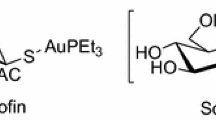Abstract
Three structurally related gold(I) carbene complexes with bulky hydrophobic ligands i.e. 1–3 were investigated in solution for further consideration as candidate anticancer agents. Cytotoxic assays were subsequently conducted on bone marrow-derived preosteoclast cell line of human origin (FLG 29.1) and human colon cancer cells (HCT-116). A far greater cytotoxic activity was measured for compound 1 against HCT-116 cells compared to 2 and 3; conversely, all compounds were highly and similarly active against FLG 29.1 cells. Results obtained for the reaction of complexes 1 and 2 with RNase A documented the occurrence of a weak interaction with this model protein and the formation of a tiny amount of the corresponding adduct. Moreover, a certain reactivity of the complex 2 was also detected toward GSH. The general implications of the obtained results are discussed.






Similar content being viewed by others
References
Bertrand B, Casini A (2014) A golden future in medicinal inorganic chemistry: the promise of anticancer gold organometallic compounds. Dalton Trans 43:4209–4219
Bertrand C, Citta A, Franken IL, Picquet M, Folda A, Scalcon V, Rigobello M, Pia L, Gendre P, Casini A, Bodio E (2015) Gold(I) NHC-based homo- and heterobimetallic complexes: synthesis, characterization and evaluation as potential anticancer agents. J Biol Inorg Chem 20:1005–1020
Chowdhury SK, Katta V, Beavis RC, Chait BT (1990) Origin and removal of adducts (molecular mass = 98 u) attached to peptide and protein ions in electrospray ionization mass spectra. J Am Soc Mass Spectrom 1:382–388
Đurović MD, Bugarčić ZD, Rominger F, Puchta R, Van Eldik R (2016) Studies on the reactivity and redox stability of gold(I/III)-carbene complexes. Unexpected inertness of a gold(I)-bis-carbene complex. Dalton Trans (submitted)
Garner ME, Niu W, Chen X, Ghiviriga I, Abboud KA, Tan W, Veige AS (2015) N-heterocyclic carbene gold(I) and silver(I) complexes bearing functional groups for bio-conjugation. Dalton Trans 44:1914–1923
Hashmi ASK, Lothschütz C, Graf K, Häffner T, Schuster A, Rominger F (2011) A short way to switchable carbenes. Adv Synth Catal 353:1407–1412
Jones G, Lautner J (1988) Chloro(dimethyl sulfide)gold(I). Acta Cryst 44:2089–2091
Lin IJB, Vasam CS (2007) Preparation and application of N-heterocyclic carbene complexes of Ag(I). Coord Chem Rev 251:642–670
Nobili S, Mini E, Landini I, Gabbiani C, Casini A, Messori L (2010) Gold compounds as anticancer agents: chemistry, cellular pharmacology, and preclinical studies. Med Res Rev 30:550–580
Öfele K (1968) 1,3-Dimethyl-4-imidazolinyliden-(2)-pentacarbonylchrom ein neuer übergangsmetall-carben-komplex. J Organomet Chem 12:42–43
Pratesi A, Gabbiani C, Michelucci E, Ginanneschi M, Papini AM, Rubbiani R, Ott I, Messori L (2014) Insights on the mechanism of thioredoxin reductase inhibition by gold N-heterocyclic carbene compounds using the synthetic linear selenocysteine containing C-terminal peptide hTrxR(488–499): an ESI-MS investigation. J Inorg Biochem 136:161–169
Ray S, Mohan R, Singh JK, Samantaray MK, Shaikh MM, Panda D, Ghosh P (2007) Anticancer and antimicrobial metallopharmaceutical agents based on palladium, gold, and silver N-heterocyclic carbene complexes. J Am Chem Soc 129:15042–15053
Wanzlick HW, Schönherr HJ (1968) Direct Synthesis of a Mercury Salt-Carbene Complex. Angew Chem Int Ed Engl 7:141–142
Acknowledgments
AP, DC and LM gratefully acknowledge the financial support from Beneficentia Stiftung (Vaduz, Liechtenstein), Ente Cassa di Risparmio di Firenze and AIRC (IG-16049). MDD and ZDB acknowledge the Ministry of Education, Science and Technological Development Serbia, project No. 172011. MDD acknowledge the research grant from the Deutscher Akademischer Austauschdienst (DAAD), Germany.
Author information
Authors and Affiliations
Corresponding authors
Rights and permissions
About this article
Cite this article
Pratesi, A., Cirri, D., Đurović, M.D. et al. New gold carbene complexes as candidate anticancer agents. Biometals 29, 905–911 (2016). https://doi.org/10.1007/s10534-016-9962-0
Received:
Accepted:
Published:
Issue Date:
DOI: https://doi.org/10.1007/s10534-016-9962-0




